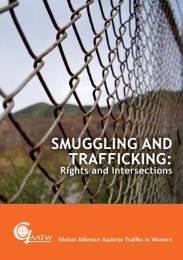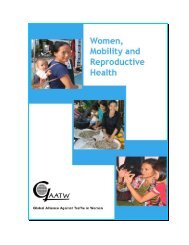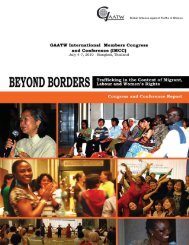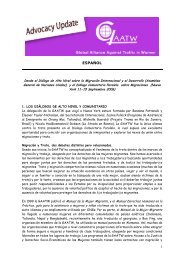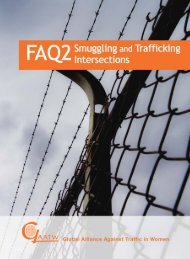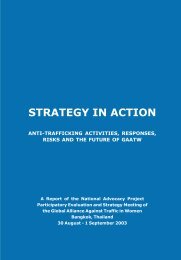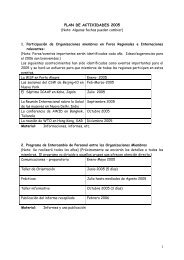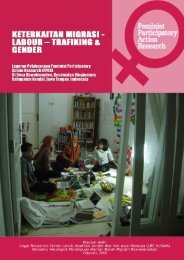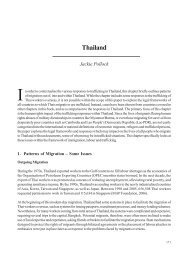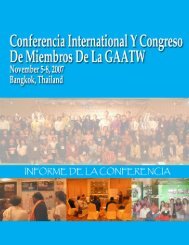Exploring Links between Trafficking and Migration - Global Alliance ...
Exploring Links between Trafficking and Migration - Global Alliance ...
Exploring Links between Trafficking and Migration - Global Alliance ...
- No tags were found...
Create successful ePaper yourself
Turn your PDF publications into a flip-book with our unique Google optimized e-Paper software.
<strong>Exploring</strong> <strong>Links</strong> <strong>between</strong> <strong>Trafficking</strong> <strong>and</strong> <strong>Migration</strong>INTRODUCTIONThe <strong>Global</strong> <strong>Alliance</strong> Against Traffic in Women (GAATW) was launched in 1994by a group of women’s rights activists looking for answers to simple questions:Why do women migrate? Why do some of them end up in exploitativesituations? What types of jobs are they entering into? Which human rightsare being violated before, during, <strong>and</strong> after their journey? How are theyshowing resistance to abuses <strong>and</strong> achieving their migratory goals? Answeringthese questions became a collaborative effort involving countless organisations<strong>and</strong> individuals over the years, <strong>and</strong> contributed to creating a moresophisticated anti-trafficking framework.This anti-trafficking framework has in many cases contributed to protectingthe rights of trafficked persons. However, excessive focus on the issue ofhuman trafficking over the last several years has also tended to ignoreother related phenomena, such as people’s experiences in migration <strong>and</strong>work. Consequently, anti-trafficking has become somewhat isolated fromits context <strong>and</strong> is now a highly specialised field. Such specialisation doesoccur in every field of knowledge <strong>and</strong> is to some extent necessary. Yet,there is a danger in trying to address the problem of human traffickingwithout underst<strong>and</strong>ing the changing context of labour <strong>and</strong> migration in arapidly globalising world. By doing so we would be looking at traffickingexclusively as a crime <strong>and</strong> not as the end result of a number of interconnectedsocial factors. Further, our underst<strong>and</strong>ing will lack the ability to createprogressive political change unless we analyse the complex social realityfrom a gender <strong>and</strong> human rights perspective.At a practical level we have observed that this segregation of expertise isimpairing our ability to assist people or effect change when rights violations arehappening. As the research documented in Collateral Damage (GAATW, 2007)pointed out, anti-trafficking initiatives have in some instances harmed thevery people whose rights they have claimed to protect. Exclusive focus ontrafficking without a social analysis also contributes to sensationalism. It createsthe false impression that trafficking is a problem that can be solved by merelytaking a few legal measures <strong>and</strong> providing assistance to those identified astrafficked. Thus, the long term goal of advocating for systemic <strong>and</strong> structuralchanges in society gets overlooked. Regrettably, while many of us in civil societyfind ourselves in specialised niche areas, sometimes our advocacy efforts in onearea may run counter to the advocacy efforts made by other social movements.For example, our loud condemnation of exploitation of women migrant workersmay encourage the states to stop women from migrating altogether. Indeed,strict border controls have been touted as anti-trafficking measures.How do we then condemn rights violations, but also expose the agenda ofstates as protectionist towards women? How do we uphold rights of migratingpeople, but not let the state abdicate its responsibilities towards its citizens<strong>and</strong> their right to livelihood in their own countries? How do we exposeworkplace exploitation <strong>and</strong> advocate for st<strong>and</strong>ard wages for all, but not letour advocacy result in a large number of people losing their jobs <strong>and</strong> beingreplaced by another set of workers in some other place?Obviously, there are no easy solutions. As we see it, underst<strong>and</strong>ing theexisting links among the issues, starting inter-movement dialogues, <strong>and</strong>collaborating with colleagues on concrete cases are essential steps.1



